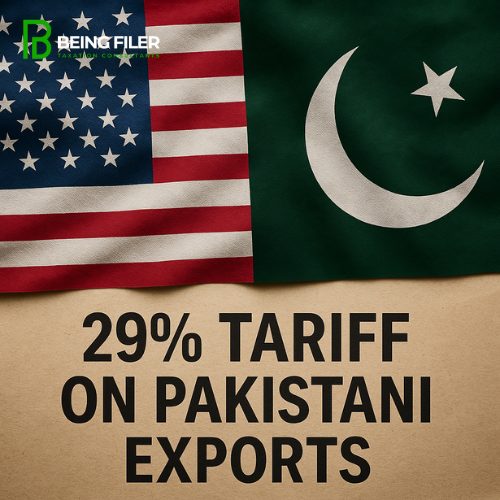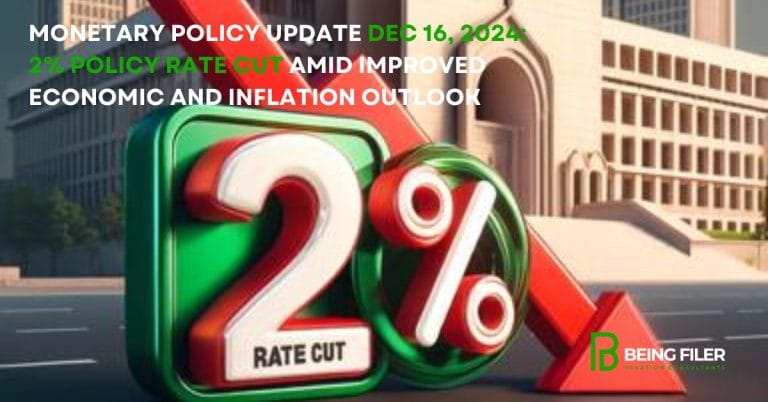US Tariffs on Pakistan: A 29% Blow to Exports—Threats, Impacts, and Strategic Opportunities

In a major shakeup of global trade dynamics, US tariffs on Pakistan have surged to 29%, dealing a significant blow to bilateral trade and Pakistan’s export economy. This action is part of a wider move under former President Donald Trump’s revived protectionist policy, imposing reciprocal tariffs on over 180 countries. Trump justified the decision by citing Pakistan’s high tariff barriers—up to 58% on American imports—prompting retaliatory steps from the U.S.
The 29% tariff directly affects Pakistan’s critical textile sector, which makes up nearly 90% of total exports to the U.S., valued at over $5 billion in FY24. Product categories 61, 62, 63, and 52—covering knitwear, woven apparel, home textiles, and cotton fabrics—are now costlier under the updated US tariff list on Pakistan goods, severely affecting exporters like Interloop Limited, Nishat Mills, Gul Ahmed, and Kohinoor Textile. Non-textile exporters such as Pak Elektron, which recently broke into the American market with transformers, are also impacted.
US Tariffs Threats and Opportunities for Pakistan
پاکستان پر امریکی ٹیرف میں اضافہ ایک بڑا معاشی جھٹکا ہے، جس سے خاص طور پر ٹیکسٹائل انڈسٹری متاثر ہو رہی ہے جو امریکی مارکیٹ میں پاکستانی برآمدات کا 90 فیصد حصہ رکھتی ہے۔ امریکہ نے 29 فیصد ٹیرف عائد کر دیا ہے، جس سے پاکستانی مصنوعات مہنگی ہو کر مسابقت کھو بیٹھیں گی۔ اگرچہ یہ اقدام نقصان دہ ہے، مگر اس میں مواقع بھی چھپے ہیں—کیونکہ دیگر ممالک جیسے ویتنام اور بنگلہ دیش پر اس سے بھی زیادہ ٹیرف لگے ہیں۔ پاکستان اگر اپنی لاگت، معیار اور ترسیل کو بہتر بنائے تو امریکی خریدار اب بھی اس کی طرف رجوع کر سکتے ہیں۔ یہ وقت ہے کہ پاکستان تجارتی تنوع، اصلاحات، اور سفارتی حکمت عملی کے ذریعے اس بحران کو موقع میں بدل دے۔
Comparatively, Pakistan is now at a relative disadvantage to India, which faces a slightly lower 26% tariff. While Vietnam and Bangladesh are facing even steeper duties (46% and 37% respectively), India’s marginal edge could allow it to expand its U.S. footprint—particularly in competing textile categories. As these nations refocus on alternative markets like Europe, US tariffs on Pakistan imports may also increase indirect pressure, as competition intensifies globally.
Major Export Goods from Pakistan to the US
Pakistan’s export profile to the U.S. is dominated by a narrow but strong lineup of goods. Key sectors include:
- Textiles and Apparel: The backbone of Pakistan’s exports, including t-shirts, jeans, hoodies, bedsheets, towels, and denim (HS Codes 52, 61, 62, 63).
- Leather Goods: Finished leather jackets, gloves, belts, and wallets.
- Surgical Instruments: High-precision tools from Sialkot catering to hospitals and clinics.
- Sporting Goods: Especially hand-stitched footballs used in FIFA tournaments.
- Footwear: Leather and synthetic shoes, though with lower market penetration.
- Carpets and Rugs: Noted for craftsmanship and export value.
- Electrical Goods: Fans, transformers, wiring, with companies like Pak Elektron leading.
- Pharmaceutical & Chemical Ingredients: APIs (Active Pharmaceutical Ingredients) and industrial chemicals.
- Agro-Products: Basmati rice, pink salt, and seasonal fruits like mangoes.

These product categories form the core of the US tariff list on Pakistan goods, and are now navigating the double challenge of global competition and new tariff-induced cost pressures.
Understanding Tariffs and Their Impact
Tariffs are government-imposed taxes on imports or exports, often used to protect local industries or as tools in geopolitical negotiation. The recent US tariffs on Pakistan imports aim to correct what Washington views as unbalanced trade terms. The result: higher prices for Pakistani goods in American markets, reduced competitiveness, and potential drops in export volume. Though tariffs may encourage U.S. domestic production, they risk damaging supply chain relationships and raising costs for American consumers.
A Critical Blow — But Also a Wake-Up Call for Pakistan
The timing couldn’t be worse. With a trade deficit already crossing $15 billion in the first eight months of FY25, Pakistan’s economy is battling slow growth, energy crises, and inflation. The U.S. remains Pakistan’s top export destination, especially for textiles. Losing traction in this market could cause severe foreign exchange shortfalls.
That said, this challenge should prompt a shift in strategy. Despite the tariff hike, Pakistan’s pricing remains competitive—often lower than Vietnam and China. With improved energy pricing, streamlined logistics, and targeted government support, exporters could retain U.S. buyers by offering value that outweighs the tariff cost.
Opportunities in Adversity: Diversification and Diplomacy
The crisis underscores Pakistan’s over-reliance on a handful of export markets. With the US tariffs on Pakistan disrupting the core, it’s time to diversify—targeting regions like the EU, Middle East, and Africa.
Surprisingly, the wider US tariffs threats and opportunities for Pakistan may hold hidden upside. The U.S. is targeting over 180 nations—many of whom are direct competitors. Vietnam (46% tariff), Bangladesh (37%), and even China are all impacted. This creates a rare window where Pakistan, despite the 29% hit, might still emerge as a viable low-cost supplier. Buyers looking to minimize cost disruptions may turn to Pakistani suppliers known for delivering on quality and reliability. Retail giants like Walmart, Target, and Macy’s could increase sourcing from Pakistan—if exporters act decisively.
Additionally, this geopolitical moment could reinvigorate calls for a preferential trade agreement or even a Free Trade Agreement (FTA) with the U.S.—a move that could neutralize future tariff shocks and deepen strategic ties.
Policy Reforms Are Urgently Needed to Offset US Tariffs on Pakistan
To survive and evolve, Pakistan must implement immediate policy measures: reduced energy tariffs for exporters, expedited tax refunds, subsidized freight, and better access to low-cost capital. Long-term, structural reforms—especially in value addition, R&D, digital transformation, and branding—are key.
Simultaneously, Pakistan must prepare to defend its domestic market. As other countries divert exports due to U.S. restrictions, local markets may face dumping threats. Anti-dumping duties and vigilant trade oversight are needed to protect domestic industry from unfair competition.
Conclusion: Surviving the Storm, Seizing the Moment
The US tariffs on Pakistan are undoubtedly disruptive—but they don’t have to be devastating. With smart policy action, diplomatic finesse, and a pivot toward efficiency and diversification, Pakistan can adapt. This is more than just a trade challenge—it’s a test of national resilience and vision.
By embracing innovation, negotiating smarter, and expanding its market reach, Pakistan can not only recover—but potentially reshape its global trade identity in a post-tariff world.
Read more about the Economy, News and Announcements here.







